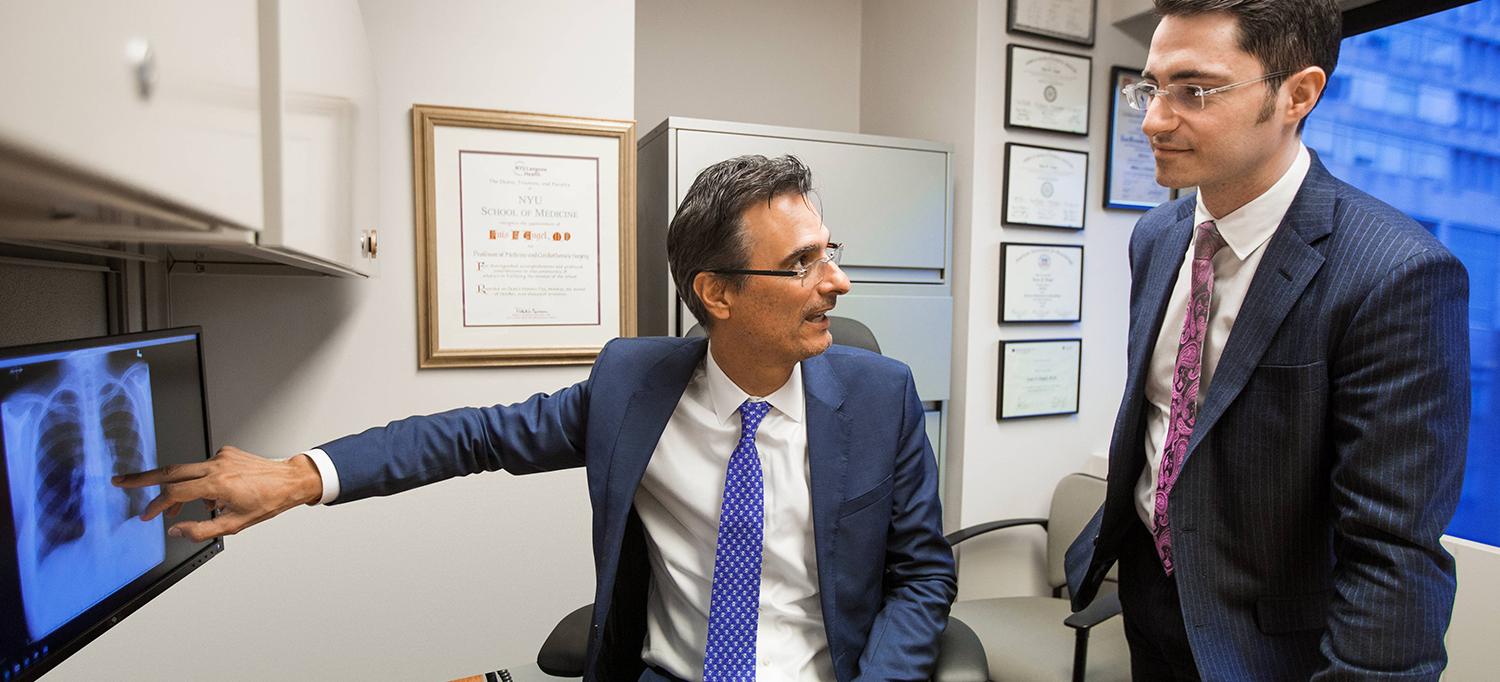
Dr. Luis F. Angel and Dr. Zachary N. Kon
Photo: NYU Langone Staff
With a multidisciplinary team approach and an enhanced focus on patient experience, NYU Langone’s new lung transplantation program, launched in January 2018, is already achieving an incredibly high transplant rate, low wait-list time for patients, and short postoperative lengths of stay.
In December 2018, after less than a year in operation, the lung transplant team at NYU Langone performed its 22nd transplant, achieving the highest transplant rate in the region. Led by medical director Luis F. Angel, MD, professor in the Departments of Medicine and Cardiothoracic Surgery, and surgical director Zachary N. Kon, MD, assistant professor in the Department of Cardiothoracic Surgery, the team employs the full gamut of bridge-to-transplant technologies, including extracorporeal membrane oxygenation (ECMO), so they can care for the most critically ill patients, while also working closely with donor organizations to make more lungs available to more patients.
“We are able to perform transplants for patients before they get too sick and require a prolonged hospital stay or complicated course pre- or postoperatively. And we do this by aggressively assessing every single donor lung offer,” says Dr. Angel, who spearheaded the creation of the Lung Donor Management Center which works closely with organ procurement organizations (OPOs) in New York, providing them access to on-call pulmonologists available 24 hours a day, 7 days a week to assist with managing deceased donors.
Increasing the Donor Pool, Shortening Wait Time
Currently only 15 to 20 percent of donor lungs are effectively utilized (compared to 30 percent for donor hearts), but research suggests a significant portion of lungs deemed unsuitable are actually transplantable. One group of particular interest to Dr. Kon and his colleagues are overdose-death donors. In a recent study, Dr. Kon and fellow researchers analyzed 17 years of data from the Scientific Registry of Transplant Recipients. While they found a three-fold increase in lungs from overdose donors over that time, this number still lags behind all other solid organ donations from this group, in part due to concerns over infection risk and allograft function.
Another finding: overdose-death donors had significantly higher rates of hepatitis C (HCV) than other donors, yet recipient survival rates were the same. Given that a quarter of the discarded lungs were from HCV-positive donors, the researchers suggest that a re-examination of current discard practices could result in more availability for the nearly 1,500 patients now on the national wait list.
In the meantime, the lung transplant team is enrolling wait-list patients in a pilot trial led by Dr. Kon and Dr. Angel. HCV-negative patients receive HCV-positive donor lungs and then undergo an eight-week antiviral treatment approved by the Federal Drug Administration (FDA) this past spring. The team has also been preparing to enroll patients in a national trial employing ex vivo lung perfusion (EVLP) technology to access and recondition marginal donor lungs, an area in which Dr. Kon has extensive experience. The EVLP process improves the quality of lungs by maintaining and evaluating donor lungs outside the body for several hours and treating them with a solution of nutrients and oxygen to reverse lung injury. This enhances the donor lungs’ transplant viability.
Improving Patient Recovery Through ERAS and Telemedicine
To cut the time patients spend in the hospital following transplant, the team developed an early recovery after surgery (ERAS) protocol. “ERAS plans are often used in general thoracic surgery, adult cardiac surgery, and other general surgeries, but they are not typically applied to complex cases like transplants,” says Dr. Kon.
Here, the ERAS plan starts in the operating room: surgeons preferentially approach all bilateral lung transplants with a less invasive surgical approach that avoids transecting the sternum. This offers faster recovery, improved chest wall mechanics, decreased wound complication rates, and more acceptable aesthetic results. Then, for postoperative care, patients begin a multimodality pain regime and aggressive, multidisciplinary physical therapy. “Just because this is a big operation doesn’t mean we can’t treat our patients like we do in nearly every other surgery in the world, where people want to recover faster and get out of the hospital sooner,” says Dr. Kon.
To further enhance the patient experience, Dr. Angel is leading a telemedicine initiative. “We now have most of our transplant patients monitored remotely, alternating appointments between NYU Langone and home,” says Dr. Angel. “This has allowed them to be more involved in their own care, input their vital signs and pulmonary function tests, and discuss labs and radiographs remotely.”